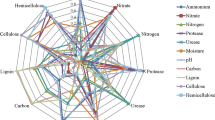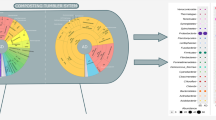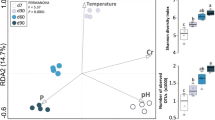Abstract
Comparative analyses of bacterial community successions in the composting materials were done for a conventional windrow post-treatment (WPOT) process with the hyperthermophilic pre-treatment (HTPRT) and simple windrow composting (SWC; without the HTPRT). Multidimensional scaling profiles based on data of terminal restriction fragment length polymorphisms of the bacterial population in the samples of every 7 days composting material and analyses of the 16S rRNA gene-based clone library of the 7 and 21 days composting materials suggested that bacterial communities of the composting materials differed much between these two processes until the 35 days of composting, whereas that they were closely related to each other at the final composting stage (42 days of composting). Detailed phylogenetic analysis clarified that all WPOT clone libraries contained many clones of the lineages of aerobic bacteria (for example, bacilli). However, the most abundant clones retrieved from all SWC materials were affiliated with a clone cluster closely related to identified and classified members of the phylum Firmicutes that have strictly anaerobic metabolism pathways. From these results, we conclude that the HTPRT process contributed to easily establish an aerobic ecosystem from the early stage to the final stage of WPOT composting with plowing the materials only once a week.
Access this article
We’re sorry, something doesn't seem to be working properly.
Please try refreshing the page. If that doesn't work, please contact support so we can address the problem.



Similar content being viewed by others
References
Brauman A, Muller JA, Garcia JL, Brune A, Schink B (1998) Fermentative degradation of 3-hydroxybenzoate in pure culture by a novel strictly anaerobic bacterium, Sporotomaculum hydroxybenzoicum gen. nov., sp. nov. Int J Syst Bacteriol 48:215–221
Bray JR, Curtis JT (1957) An ordination of the upland forest communities of southern Wisconsin. Ecol Monographs 27:325–349
Cahyani VR, Matsuya K, Asakawa S, Kimura M (2003) Succession and phylogenetic composition of bacterial communities responsible for the composting process of rice straw estimated by PCR-DGGE analyses. Soil Sci Plant Nutr 49:619–630
Chefetz B, Chen Y, Hadar Y (1998) Purification and characterization of laccase from Chaetomium thermophilum and its role in humidification. Appl Environ Microbiol 64:3175–3179
Clarke KR (1993) Non-parametric multivariate analysis of changes in community structure. Aust J Ecol 18:117–143
Dees PM, Ghiorse WC (2001) Microbial diversity in hot synthetic compost as revealed by PCR-amplified rRNA sequences from cultivated isolates and extracted DNA. FEMS Microbial Ecol 35:207–216
Egert M, Friedrich MW (2003) Formation of pseudo-terminal restriction fragments, a PCR-related bias affecting terminal restriction fragment length polymorphism analysis of microbial community structure. Appl Environ Microbiol 69:2555–2562
Felsenstein J (1985) Confidence limits on phylogenies: an approach using the bootstrap. Evolution 39:783–791
Green SJ, Michel FC, Hadar Y, Minz D (2004) Similarity of bacterial communities in sawdust- and straw-amended cow manure composts. FEMS Microbiol Lett 233:115–123
Hatayama K, Shoun H, Ueda Y, Nakamura A (2005) Planifilum fimeticola gen. nov., sp. nov. and Planifilum fulgidum sp. nov., novel members of the family ‘Thermoactinomycetaceae’ isolated from compost. Int J Syst Evol Microbiol 55:2101–2104
Hiraishi A, Narihiro T, Yamanaka Y (2003) Microbial community dynamics during start-up operation of flowerpot-using fed-batch reactors for composting of household biowaste. Environ Microbiol 5:765–776
Hugenholtz P, Huber T (2003) Chimeric 16S rDNA sequences of diverse origin are accumulating in the public databases. Int J Syst Evol Microbiol 53:289–293
Imachi H, Sekiguchi Y, Kamagata Y, Hanada S, Ohashi A, Harada H (2002) Pelotomaculum thermopropionicum gen. nov., sp. nov., an anaerobic, thermophilic, syntrophic propionate-oxidizing bacterium. Int J Syst Evol Microbiol 52:1729–1735
Imachi H, Sakai S, Ohashi A, Harada H, Hanada S, Kamagata Y, Sekiguchi Y (2007) Pelotomaculum propionicum sp. nov., an anaerobic, mesophilic, obligately syntrophic, propionate-oxidizing bacterium. Int J Syst Evol Microbiol 57:1487–1492
Jobb G (2008) TREEFINDER version June of 2008. Munish, Germany Distributed by the author at http://www.treefinder.de
Kruskal JB (1964) Multidimensional scaling by optimizing goodness of fit to a nonmetric hypothesis. Psychometrika 298:1–27
Kuroda K, Hanajima D, Fukumoto Y, Suzuki K (2004) Isolation of thermophilic ammonium-tolerant bacterium and Its application to reduce ammonia emission during composting of animal wastes. Biosci Biotechnol Biochem 68:286–292
Ludwig W, Strunk O, Westram R, Richter L, Meier H, Yadhukumar, Buchner A, Lai T, Steppi S, Jobb G, Förster W, Brettske I, Gerber S, Ginhart AW, Gross O, Grumann S, Hermann S, Jost R, König A, Liss T, Lüßmann R, May M, Nonhoff B, Reichel B, Strehlow R, Stamatakis A, Stuckmann N, Vilbig A, Lenke M, Ludwig T, Bode A, Schleifer KH (2004) ARB: a software environment for sequence data. Nucleic Acids Res 32:1363–1371
Lukow T, Dunfield PF, Liesack W (2000) Use of the T-RFLP technique to assess spatial and temporal changes in the bacterial community structure within an agricultural soil planted with transgenic and non-transgenic potato plants. FEMS Microbiol Ecol 32:241–247
Nakasaki K, Uehara N, Kataoka M, Kubota H (1996) The use of Bacillus licheniformis HA1 to accelerate composting of organic wastes. Comp Sci Util 4:47–51
Osborn AM, Moore ERB, Timmis KN (2000) An evaluation of terminal restriction fragment length polymorphism (T-RFLP) analysis for the study of microbial community structure and dynamics. Environ Microbiol 2:39–50
Peters S, Koschinsky S, Schwieger F, Tebbe C (2000) Succession of microbial communities during hot composting as detected by PCR-single-strand-conformation polymorphism-based genetic profiles of small-subunit rRNA genes. Appl Environ Microbiol 66:930–936
Peu P, Brugère H, Pourcher AM, Kérourdan M, Godon JJ, Delgenès JP, Dabert P (2006) Dynamic of a pig slurry microbial community during anarobic storage and management. Appl Environ Microbiol 72:3578–3585
Qiu YL, Sekiguchi Y, Imachi H, Kamagata Y, Tseng IC, Cheng SS, Ohashi A, Harada H (2003) Sporotomaculum syntrophicum sp. nov., a novel anaerobic, syntrophic benzoate-degrading bacterium isolated from methanogenic sludge treating wastewater from terephthalate manufacturing. Arch Microbiol 179:242–249
Rees GN, Baldwin DS, Watson GO, Perryman S, Nielsen DL (2004) Ordination and significance testing of microbial community composition derived from terminal restriction fragment length polymorphisms: application of multivariate statistics. Antonie Leeuwenhoek 86:339–347
Requena N, Azcón R, Baca MT (1996) Chemical changes in humic substances from compost due to incubation with ligno-cellulotic microorganisms and effects on lettuce growth. Appl Microbiol Biotechnol 45:857–863
Saitou N, Nei M (1987) The neighbor-joining method: a new method for reconstructing phylogenetic trees. Mol Biol Evol 4:406–425
Sasaki H, Yano H, Sasaki T, Nakai Y (2005) A survey of ammonia-assimilating micro-organisms in cattle manure composting. J Appl Microbiol 99:1356–1363
Stevenson FJ (1994) Humus chemistry. Wiley, New York
Swofford DL (2002) PAUP*: phylogenetic analysis using parsimony (* and other methods), version 4. Sinauer, Sunderland
Tang Y, Shigematsu T, Ikbal, Morimura S, Kida K (2004) The effects of micro-aeration on the phylogenetic diversity of microorganisms in a thermophilic anaerobic municipal solid–waste digester. Water Res 38:2537–2550
Tiquia SM (2005) Microbial community dynamics in manure composts based on 16S and 18S rDNA T-RFLP profiles. Environ Technol 26:1101–1113
Wakase S, Sasaki H, Itoh K, Otawa K, Kitazume O, Nonaka J, Satoh M, Sasaki T, Nakai Y (2008) Investigation of the microbial community in a microbiological additive used in a manure composting process. Bioresor Technol 99:2687–2693
Wei Z, Xi B, Zhao Y, Wang S, Liu H, Jiang Y (2007) Effect of inoculation microbes in municipal solid waste composting on characteristics of humic acid. Chemosphere 68:368–374
Weisburg WG, Barns SM, Pelletier DA, Lane DJ (1991) 16S ribosomal DNA amplification for phylogenetic study. J Bacteriol 173:697–703
Yamada T, Miyauchi K, Ueda H, Ueda Y, Sugawara H, Nakai Y, Endo G (2007) Composting cattle dung wastes by using a hyperthermophilic pre-treatment process: characterization by physicochemical and molecular biological analysis. J Biosci Bioeng 104:408–415
Acknowledgments
This study was part of a project supported by the Research and Development Program for New Bio-industry Initiatives, Tokyo, Japan. We thank Hiroyuki Sugawara and Yukihiro Nakai at Tohoku Gakuin University for their help in the T-RFLP study work. We also thank Masaki Tamayose for his help in the WPOT and SWC processed compost production.
Author information
Authors and Affiliations
Corresponding author
Rights and permissions
About this article
Cite this article
Yamada, T., Suzuki, A., Ueda, H. et al. Successions of bacterial community in composting cow dung wastes with or without hyperthermophilic pre-treatment. Appl Microbiol Biotechnol 81, 771–781 (2008). https://doi.org/10.1007/s00253-008-1736-3
Received:
Revised:
Accepted:
Published:
Issue Date:
DOI: https://doi.org/10.1007/s00253-008-1736-3




